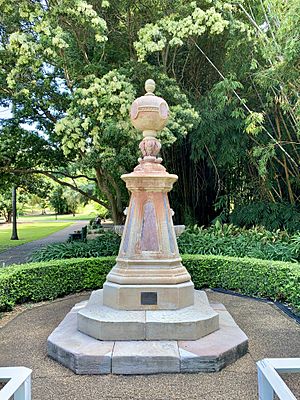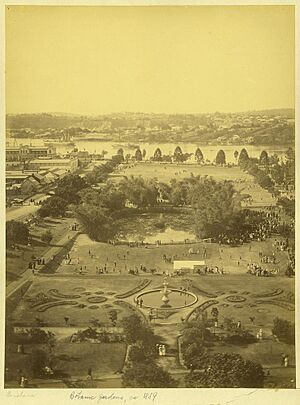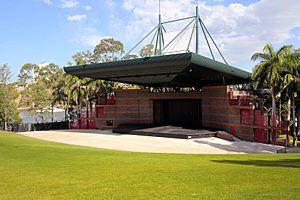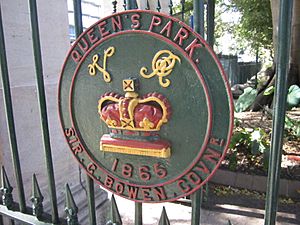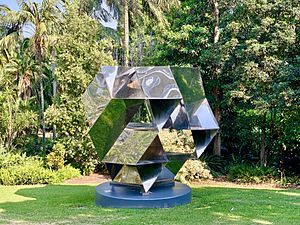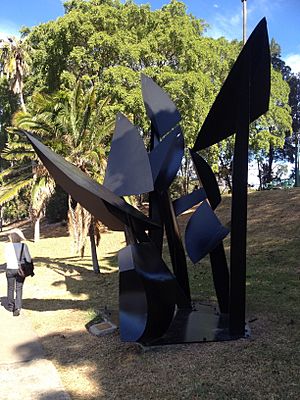City Botanic Gardens facts for kids
Quick facts for kids City Botanic Gardens |
|
|---|---|
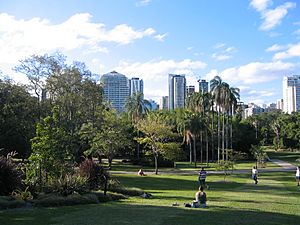
City Botanic Gardens with buildings in the CBD visible in the background
|
|
| Type | Botanical |
| Location | Brisbane, Queensland, Australia |
| Area | 200,000 m2 (49 acres) |
| Owned by | Brisbane City Council |
| Designation | State Heritage Place (Queensland Heritage Register) |
| City Botanic Gardens | |
|---|---|
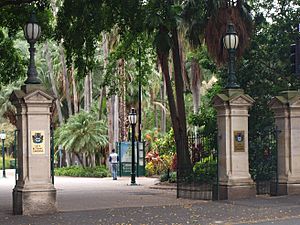
Entrance gates, Albert Street, 2016
|
|
| Location | 147 Alice Street, Brisbane City, City of Brisbane, Queensland, Australia |
| Design period | 1824–1841 Convict settlement |
| Official name: Brisbane Botanic Gardens, Queen's Park, Walter Hill Fountain | |
| Type | state heritage (built, landscape) |
| Designated | 3 February 1997 |
| Reference no. | 600067 |
| Significant period | 1865-1920s (fabric) 1828–1855, 1855-1970s, (historical) 1855-ongoing (social) |
| Significant components | drain – storm water, gate – entrance, animal enclosure/s, garden – bed/s, tree groups – avenue of, wall/s – retaining, residential accommodation – housing, rotunda, pathway/walkway, lake / pond / waterway, tree groups – copse, fountain, steps/stairway, trees/plantings, garden/grounds, wall/s, amphitheatre |
| Lua error in Module:Location_map at line 420: attempt to index field 'wikibase' (a nil value). | |
The City Botanic Gardens (once called the Brisbane Botanic Gardens) is a special garden with a long history. It is located on Alice Street in Brisbane City, Queensland, Australia. The gardens are on Gardens Point in the heart of Brisbane. They are surrounded by the Brisbane River, Alice Street, George Street, Parliament House, and the Queensland University of Technology campus. The gardens started in 1825 as a farm for the Moreton Bay prison colony.
These gardens have Brisbane's oldest plants. Many rare and unusual plant types grow here. You can see special collections of cycads, palms, figs, and bamboo.
The City Botanic Gardens were added to the Queensland Heritage Register in 1997. This means they are a very important historical place. The register says the gardens are "the most significant, non-Aboriginal cultural landscape in Queensland". This is because they have been a garden since 1828 and have not changed much. They are still the main public park and fun place for Brisbane.
Contents
History of the City Botanic Gardens
Much of the Botanic Gardens was chosen as a garden spot in 1828. This was done by Charles Fraser, a botanist from New South Wales. It happened three years after the Moreton Bay prison colony was set up nearby. Convicts first planted food crops here in 1825 to feed the prison colony.
In 1855, a part of the land became a special Botanic Reserve. That same year, Walter Hill became the curator, or manager, of the gardens. He worked there until 1881. Hill started planting many new types of plants and doing experiments. Some of the old trees in the gardens were the first of their kind planted in Australia. This was because Hill tried to grow plants from other places here.
He tested plants that could be useful or make money. Hill brought in mango, pawpaw, ginger, and tamarind trees. He also introduced mahogany, poinciana, and jacaranda trees. He tested tobacco, sugar, grape vines, wheat, tropical fruits, tea, coffee, spices, and plants for making cloth. He helped John Buhot grow sugar cane, which led to the first granulated sugar made in Queensland in 1862. A stone monument marks where the sugar cane grew. Hill also supported the Queensland Acclimatisation Society, which started in 1862. The Botanic Gardens helped grow and share the plants this society brought in.
By 1866, Hill made the Botanic Gardens bigger, to about 27 acres. A 10-acre strip along Alice Street was not part of the gardens. It was a park and sports field called Queen's Park.
Early buildings in the area included a manager's house in the late 1850s. A platform for cannons was built in the early 1860s. A stone and iron fence was put around Queen's Park in 1865–66. The stone came from an old jail. A drinking fountain was built in 1867. This fountain was designed by Charles Tiffin, a colonial architect. It was built just one year after Brisbane got piped water from the Enoggera reservoir. This fountain later became known as the Walter Hill fountain.
Rows of weeping figs were planted in the 1870s. Hill also planted long lines of Bunya pines and Cook pines.
People used the gardens for fun, along with the Domain and Queen's Park. By the 1880s, some of the plant research moved to Bowen Park. The Herbarium (a collection of dried plants) and Botanic Library were moved for a while. But they came back in 1905 when John Frederick Bailey became the new curator.
Underground electricity was installed in 1907.
In 1915, the riverbank at Gardens Point was dug up. This removed about 9 acres from the Domain and Botanic Gardens. But the next year, the gardens, Queen's Park, and part of the Domain joined together. This made a new Botanic Gardens of about 50 acres.
The City Botanic Gardens we see today were formed in 1916. The original Botanic Gardens, the Domain, and Queen's Park joined up. This made the total area about 20 hectares. Queen's Park was a 10-acre strip along Alice Street. It was used as a park and for sports like cricket and football. The old curator's cottage, built for John Frederick Bailey, is now a cafe.
In 1924, the Brisbane City Council took over running the Botanic Gardens. But the Herbarium stayed with the Queensland Department of Agriculture.
The gardens are close to the river and have flooded many times. Because of this, the Brisbane City Council started a new botanic gardens at Mount Coot-tha. Since the Mount Coot-tha Botanic Gardens opened in the 1970s, the City Botanic Gardens have become mostly a place for fun and relaxation. In the late 1980s, new fun structures were added. The old Queen's Park fence was also fixed.
The gardens were also home for over 100 years to Harriet. She was a tortoise said to have been found by Charles Darwin in 1835. She was given to the gardens in 1860. Harriet was named after Harry Oakman, a curator of the gardens. He also created a small zoo there, which closed in 1952. Harriet lived her last years at Australia Zoo and died in 2006.
What to See in the Gardens
The Brisbane Botanic Gardens cover 20 hectares. They are bordered by George and Alice Streets and the Brisbane River. The gardens have three main parts: the old Queen's Park, the Botanic Gardens near the river, and the former Government Domain. The Domain was once part of the grounds of Old Government House.
The gardens have rolling hills and many old shade trees. These trees also form long avenues and groves. A lake, neat lawns, and special garden areas make it a great place to relax. Paths connect a walkway along the river to other paths around the edges.
You can see an avenue of Bunya Pines (Araucaria bidwilli) planted in the 1850s. There is also an avenue of Weeping Figs (Ficus benjamina) planted in the 1870s. The gardens also have many other rare plants, especially palms and figs. Some are in neat rows, others are in mass plantings. There is also an avenue of Cook Pines (Araucaria columnaris).
A low stone wall from the 1860s with an iron railing fence runs along Alice Street. It also goes into George Street. Large iron gates let you enter at George, Albert, and Edward Streets. A cottage from around 1900, with pretty Arts and Crafts designs, is at the south end of the gardens. This building is surrounded by trees and bushes. Some of these plants are from the late 1850s and early 1860s. The City Gardens Cafe used to be here; now it is called The Garden Club.
In a dip north of the cottage is the Walter Hill fountain. It has a stepped, eight-sided base. The fountain itself is also eight-sided and gets narrower at the top. The lion-shaped drinking fountains are made of white marble. The rest of the fountain is made of freestone.
South of the cottage is a grassy amphitheatre from the 1980s called Riverstage. It faces a stage next to the river. Other buildings for public use are spread throughout the gardens.
Visiting the Gardens
You can get to the gardens from Alice Street, the Goodwill Bridge, and by Brisbane City Council's ferries and CityCats. These boats stop at the Gardens Point and Eagle St wharves. The gardens are open 24 hours a day, and the paths are lit at night.
Things to do and see in the gardens include:
- A bike hire station at the Albert Street entrance.
- Morning Star II by Jon Barlow Hudson (from World Expo 88).
- Plant form by Robert Juniper.
Why the Gardens are Important
The Brisbane Botanic Gardens were added to the Queensland Heritage Register in 1997. This means they are very important for several reasons.
They show how Queensland's history has changed. The gardens are historically important. They are the most significant cultural landscape in Queensland that was not created by Aboriginal people. They have been a garden since 1828 and have not lost land or changed their use. They are still the main public park for Brisbane.
They show rare or special parts of Queensland's history. Some plant collections date back to the 1850s. Many were planted by Walter Hill, the first Director. Many plants are rare or very old. Many important plants, both for farming and beauty, were first brought to Queensland through these gardens. This was thanks to the early curators.
They show what a public and botanical garden from the mid-1800s looks like. These gardens show what an old public and botanical garden is like. They have the most mature gardens in Queensland. There are many historic structures, like the Walter Hill Drinking Fountain (1867). Also, the old band pavilion (1878), stone walls, gates, and iron railings (1865–85). The old bear pit shelter (1905), the former curator's house (1909), and river walls and staircases from the early 1900s are also important. The gardens also have early engineering projects. These include the stormwater drainage system (from 1865), piped water from Enoggera Dam (1867), and underground electricity (1907).
They are beautiful. The Brisbane Botanic Gardens are a well-known landmark in Brisbane. They are beautiful to look at and have natural wildlife. They are the main green area in the city's center.
They are important to the community. Many important social events have happened in the gardens. Local people love the gardens, and visitors to Brisbane enjoy them too.
They are linked to important people in Queensland's history. The gardens are specially connected to the important work of curators like Walter Hill (1855–81), Philip John MacMahon (1889–1905), John Frederick Bailey (1905–1917), and Ernest Walter Bick (1917–1939).
Images for kids
See also
 In Spanish: Jardín botánico de la ciudad de Brisbane para niños
In Spanish: Jardín botánico de la ciudad de Brisbane para niños


